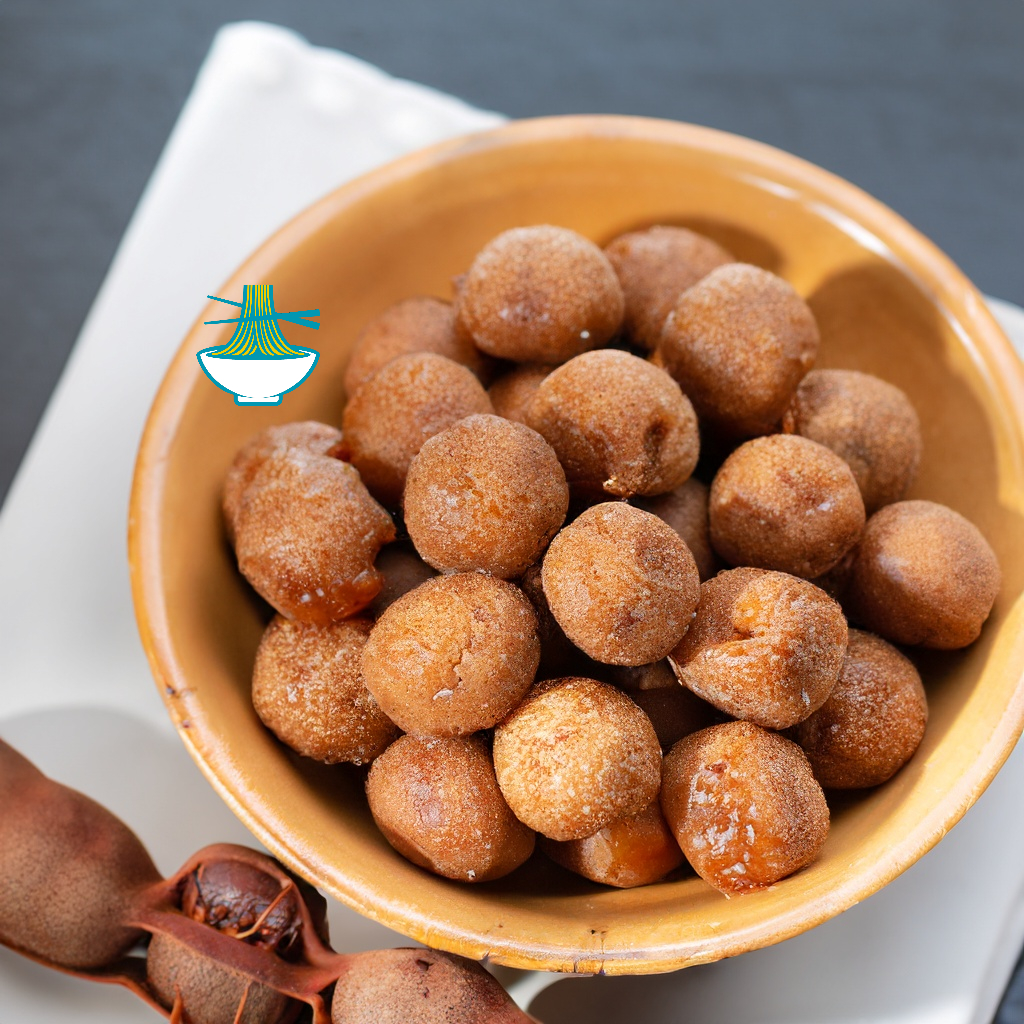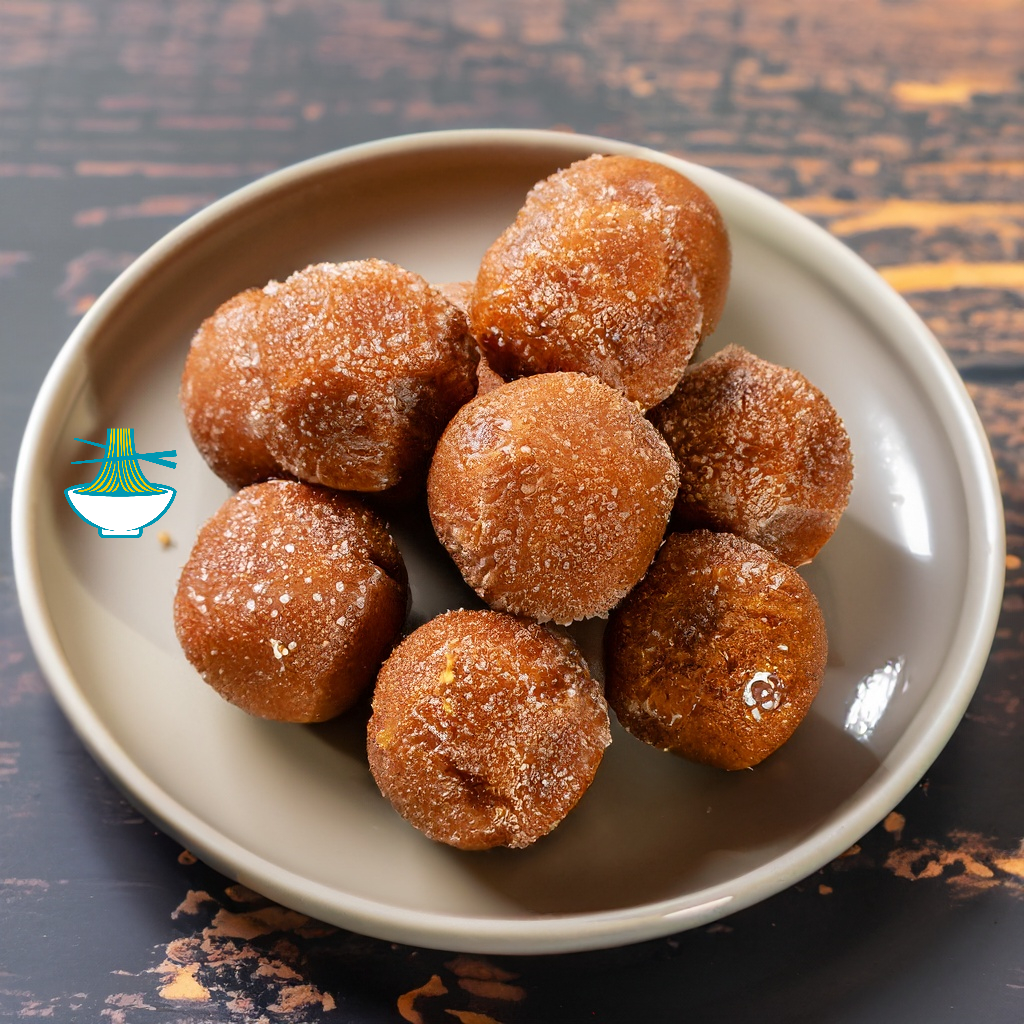Tamarind balls are a sweet and sour snack made from the pulp of the tamarind fruit, which is native to Africa and widely cultivated in tropical regions. Popular in the Caribbean and parts of South Asia, these balls offer a unique flavor, combining the tangy taste of tamarind with the sweetness of sugar. The texture is soft, chewy, and slightly sticky, with a crunchy sugar coating. In addition to their delicious taste, tamarind balls provide several nutritionalbenefits, including being low in fat and calories while offering dietary fiber and antioxidants. They can help boost the immune system and refresh the palate, especially on hot days. These homemade treats are easy to prepare and can be customized with different spices for added flavor.
ingredients:
1- 1 cup of tamarind pulp
2- 1/2 cup of brown sugar
3- 1/4 teaspoon of ground cinnamon
4- 1/4 teaspoon of ground ginger
5- 1/4 teaspoon of ground cloves
6- 1/4 teaspoon of salt
7- 1/4 cup of water
8- 1/2 cup of granulated sugar (for coating)
Method:
1- Begin by removing the seeds and strings from the tamarind pulp. You can do this by using your hands or a small knife to peel away the outer layer of the pulp.
2- Once you have removed the seeds and strings, place the tamarind pulp in a saucepan with the brown sugar, ground cinnamon, ground ginger, ground cloves, and salt.
3- Add 1/4 cup of water to the saucepan and stir the mixture together. Place the saucepan over medium heat and cook the mixture, stirring constantly, until the sugar has dissolved and the mixture has thickened.
4- Remove the saucepan from the heat and allow the mixture to cool for a few minutes. Then, use your hands to roll the mixture into small balls.
5- Spread the granulated sugar out onto a plate. Roll each tamarind ball in the sugar until it is coated on all sides.
6- Place the tamarind balls in a container with a lid and refrigerate them for at least 30 minutes, or until they are firm.
7- Once the tamarind balls have chilled, they are ready to serve. You can store them in the refrigerator for up to a week.
Health Improvements:
- To make tamarind balls healthier, consider replacing refined sugars with natural sweeteners such as stevia, monk fruit sweetener, or honey. These alternatives can help reduce the glycemic impact of the snack, making it more suitable for individuals with blood sugar concerns. Additionally, adding ingredients like chia seeds or flaxseeds can boost the fiber content, further enhancing the digestive benefits. Reducing or omitting the sugar coating can also make the snack lower in calories and more nutritious.
Note:
- You can adjust the amount of sugar in this recipe to your liking. If you prefer a less sweet tamarind ball, you can reduce the amount of sugar in the recipe. You can also add other spices or flavorings, such as vanilla extract or chili powder, to customize the recipe to your tastes.
Potential Side Effects:
- While tamarind balls are a tasty treat, it's important to be mindful of their sugar content. Consuming large amounts of sugar, particularly for individuals with diabetes or those following a low-sugar diet, can lead to spikes in blood sugar levels. For those with diabetes, it's crucial to monitor sugar intake carefully, as high sugar levels can interfere with glucose control. Additionally, the high sugar content may also contribute to weight gain if consumed excessively, so moderation is key.
Comparison with Other Sweets:
- When compared to traditional candies and sweets, tamarind balls offer a healthier alternative due to their natural ingredients. While typical candies are often made with artificial flavors and high-fructose corn syrup, tamarind balls are primarily made from fruit pulp, which provides essential nutrients like vitamin C, fiber, and antioxidants. They also contain less fat and are generally lower in calories, making them a more nutritious choice than many commercially available sugary snacks. While still containing sugar, tamarind balls offer a more balanced mix of flavors and provide some beneficial compounds.
Frequently Asked Questions (FAQs)
1. Are tamarind balls suitable for people with diabetes?
- Tamarind balls contain sugar, which can affect blood sugar levels. For individuals with diabetes, it's important to be cautious with the amount consumed. While tamarind itself offers some health benefits, the sugar in the recipe could cause spikes in blood glucose. A potential solution would be to modify the recipe by using natural sweeteners like stevia or monk fruit sweetener, which have minimal impact on blood sugar levels.
2. Can tamarind balls be made without added sugar?
- Yes, tamarind balls can be prepared without added sugar. To make them more suitable for individuals who follow a sugar-free diet, you can substitute the sugar with natural sweeteners such as stevia, honey, or maple syrup. Reducing or eliminating the sugar coating is another way to lower the sweetness and make the snack healthier.
3. How long can tamarind balls be stored?
- Tamarind balls can be stored in the refrigerator for up to one week. For best results, store them in an airtight container to prevent them from drying out. If you'd like to store them for a longer period, you can freeze them. To thaw, simply leave them at room temperature for a few hours before serving.
4. What are the other health benefits of tamarind?
- In addition to being rich in antioxidants and dietary fiber, tamarind is also known to support heart health. It contains potassium, which helps regulate blood pressure and supports proper heart function. Tamarind is also beneficial for cholesterol management, as it may help lower levels of LDL cholesterol (the "bad" cholesterol). Additionally, tamarind has anti-inflammatory properties that can aid in reducing inflammation in the body.
5. Can dried tamarind be used instead of fresh tamarind?
- Yes, dried tamarind can be used as a substitute for fresh tamarind, but there are some differences to consider. Dried tamarind has a more concentrated flavor and may require soaking in warm water to rehydrate it before use. While both forms of tamarind provide similar nutritional benefits, dried tamarind tends to have a more intense tanginess compared to the milder flavor of fresh tamarind.
Nutrition facts:
(per serving of 1 tamarind ball):
- Calories: 42
- Total fat: 0.1g
- aturated fat: 0g
- Cholesterol: 0mg
- Sodium: 29mg
- Total carbohydrates: 11.1g
- Dietary fiber: 0.3g
- Sugars: 10.2g
- Protein: 0.1g
Tamarind balls are a low-fat and low-calorie snack, making them a healthier alternative to many other types of candy or sweets. They are also a good source of dietary fiber, which can help to promote digestive health.
Here are the estimated nutrition facts for the ingredients you provided:
1 cup of tamarind pulp:
- Calories: 287
- Carbohydrates: 75 grams
- Fiber: 6 grams
- Protein: 3 grams
- Fat: 1 gram
- Vitamin C: 12% of the recommended daily intake (RDI)
- Iron: 11% of the RDI
benefits:
- Rich in Antioxidants: Tamarind is packed with antioxidants that help fight free radicals, reducing oxidative stress and inflammation.
- Digestive Health: Contains dietary fiber which aids in digestion and helps prevent constipation.
- Vitamins and Minerals: A good source of vitamins C and B, as well as potassium and magnesium, which support overall health.
1/2 cup of brown sugar:
- Calories: 432
- Carbohydrates: 111 grams
- Fiber: 0 grams
- Protein: 0 grams
- Fat: 0 grams
benefits:
- Mineral Content: Contains trace amounts of minerals such as calcium, potassium, iron, and magnesium, which are absent in refined white sugar.
- Energy Boost: Provides a quick source of energy due to its carbohydrate content.
1/4 teaspoon of ground cinnamon:
- Calories: 2
- Carbohydrates: 0.7 grams
- Fiber: 0.4 grams
- Protein: 0.1 grams
- Fat: 0.1 grams
benefits:
- Anti-inflammatory Properties: Cinnamon has potent anti-inflammatory properties that can help reduce inflammation in the body.
- Blood Sugar Control: May help improve insulin sensitivity and lower blood sugar levels, beneficial for those with type 2 diabetes.
1/4 teaspoon of ground ginger:
- Calories: 2
- Carbohydrates: 0.5 grams
- Fiber: 0.1 grams
- Protein: 0.1 grams
- Fat: 0.1 grams
benefits:
- Digestive Aid: Ginger is known to help with digestion, reduce nausea, and combat indigestion.
- Anti-inflammatory and Antioxidant Effects: Contains powerful anti-inflammatory and antioxidant compounds like gingerol.
1/4 teaspoon of ground cloves:
- Calories: 2
- Carbohydrates: 0.6 grams
- Fiber: 0.3 grams
- Protein: 0.1 grams
- Fat: 0.1 grams
benefits:
- Antimicrobial Properties: Cloves have antimicrobial properties that can help fight infections.
- Bone Health: High in manganese, cloves support bone health and improve bone density.
1/4 teaspoon of salt:
- Calories: 0
- Carbohydrates: 0 grams
- Fiber: 0 grams
- Protein: 0 grams
- Fat: 0 grams
benefits:
- Electrolyte Balance: Helps maintain proper electrolyte balance in the body, essential for hydration and muscle function.
- Flavor Enhancement: Enhances the flavor of food, making it more palatable and enjoyable.
1/4 cup of water:
- Calories: 0
- Carbohydrates: 0 grams
- Fiber: 0 grams
- Protein: 0 grams
- Fat: 0 grams
benefits:
- Hydration: Essential for maintaining hydration and supporting all bodily functions.
- Solvent: Helps dissolve other ingredients and create a consistent texture in recipes.
1/2 cup of granulated sugar (for coating):
- Calories: 387
- Carbohydrates: 100 grams
- Fiber: 0 grams
- Protein: 0 grams
- Fat: 0 grams
benefits:
- Energy Source: Provides a quick source of energy.
- Texture and Sweetness: Adds a crunchy texture and sweet flavor, enhancing the overall taste of the dish.
Please note that these values are approximate and may vary depending on the specific brand or variety of the ingredients used. Additionally, the values provided are for the individual ingredients and not for the final product or dish that may be prepared using these ingredients.


Comments